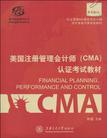美国注册管理会计师
出版时间:2010-1 出版社:上海交通大学出版社 作者:陈越 编 页数:422
前言
美国注册管理会计师的英文全称是Certified Management Accountant,简称CMA。CMA是美国注册管理会计师协会(Institute of Management Aecountants,IMA)创立的一个财务管理综合能力考核专业资格证书,内容涉及经济、金融、管理、会计等多方面内容,考试主要以基础知识、实用知识为主,知识覆盖面很广;具有很强的实用性、可操作性。 IMA由具有103年历史的美国国家会计师协会(NAA)创立,它是美国最大的会计师协会。IMA目前共有会员超过11 000人,主要分布在美国和加拿大等经济发达国家。目前CMA证书持有者主要是世界各大公司及金融机构的财务主管、财务长、CFO、CEO、成本核算师、理财师、企业管理人员。CMA与美国会计师协会(American Institute of Certified Public Accountant,AICPA)是美国两个最主要、最权威的会计师资格,也是全球最权威的会计资格。国际上的会计准则和管理标准,IMA是国际上管理会计学科最具权威的机构。 高才(中国)培训致力研发国内首套美国CMA考试辅导教材,本书在内容上除了包括所有美国CMA考试大纲规定考试范围,更添加了许多中文背景注释、高才培训的提示和专业词汇表,弥补了中国学员阅读纯英文CMA培训教材所遇到的语言和文化差异障碍;同时本系列丛书融合美国多所知名院校MBA课程内容设置,知识体系设置合理,内容翔实,理论联系实际,突出案例教学,深入浅出,易懂易学。 2009年IMA考试管理中心对CMA的整体考试内容做出了重大的调整,增添了很多新的考试内容,并提高了考试难度,高才培训第一时间推出了采用IMA 2009年最新考试大纲所编写的CMA复习材料,共两个部分,即Financial P1anning,Performance and Control和Financial Decision Making。关于考试内容结构具体变化,学员可及时联系高才(中国)培训。 衷心祝愿本套培训教材能帮助有志于成为美国注册管理会计师的朋友们一举成功!
内容概要
近年来,越来越多的中国财经、金融、管理专业人士开始关注和参加美国注册管理会计师考试。高才(中国)培训致力研发国内首套美国CMA考试双语教材,本书在内容上除了包括所有美国CMA考试大纲规定考试范围,更添加了许多中文背景注释、高才培训的提示和专业术语表,弥补了中国学员阅读纯英文CMA培训教材所遇到的语言和文化差异障碍。 本系列丛书融合美国多所知名院校MBA课程内容设置,知识体系设置合理,内容翔实,理论联系实际,突出案例教学,深入浅出,易懂易学,并对所有概念的相关的考试掌握要求逐一做了图案标识并提示了记忆技巧。适合所有美国CMA考生阅读。 作者简介: 陈越,高才(中国)培训总裁兼首席培训师。 陈越先生目前是IMA协会唯一业裔董事,曾担任美国多家公司高级财务分析师,取得多项财会类CPA,CMA,CFM,CIA,AIA,LIFA权威证书,同时有着丰富的授课经验。 美国管理会计师协会董事会(Institute of Management Accountants)董事 同际金融协会(Institute of Research Associat ion)董事 美国注册会计师协会会员(American Institute of Certifled Accountants) 美国内部审计师协会会员(Institute of Internal Auditors) 英国国际会计师协会会员(Association of International Accountants) 2006年1月担任“哈佛上海论坛”财务部分 主讲 登入2003年世界名人录——“Who's Who”(财经类)并取得证书 登入2002年斯特莫北美名人录——“Who's Who”(财经类)并取得证书
书籍目录
Chapter One Planning, Budgeting and Forecasting (30%-Levels A, B, and C) 1.1 IMA LOS 1.2 Budgeting Preparation 1.2.1 Operations and Performance Goals 1.2.2 Characteristics of a Successful Budget Process 1.2.3 Management by Objective and Budgeting 1.3 Forecasting Techniques 1.3.1 Regression Analysis 1.3.2 Learning Curve Analysis 1.3.3 Exponential Smoothing 1.3.4 Time Series Analysis 1.3.5 Expected Value 1.4 Budgeting Mmethodologies 1.4.1 Annual Business Plans (Master Budgets) 1.4.2 Project Budgeting 1.4.3 Activity-based Budgeting 1.4.4 Zero-based Budgeting 1.4.5 Continuous (Roiling) Budgets 1.4.6 Flexible Budgeting 1.5 Annual Profit Plan and Supporting Schedules 1.5.1 Operational Budgets 1.5.2 Financial Budgets 1.5.3 Capital Budgets 1.6 Top-level Planning and Analysis 1.6.1 Pro forma Income 1.6.2 Cash Flow ProjectionsChapter Two Performance Management (25%-Levels A, B, and C) 2.1 IMA LOS 2.2 Cost and Variance Measures 2.2.1 Comparison of Actual to Planned Results 2.2.2 Use of Static and Flexible Budgets to Analyze Performance 2.2.3 Management by Exception 2.2.4 Use of Standard Cost Systems 2.2.5 Analysis of Variation from Standard Cost Expectations 2.3 Responsibility Centers and Reporting Segments 2.3.1 Types of Responsibility Centers 2.3.2 Transfer Pricing 2.3.3 Reporting of Organizational Segments 2.4 Performance Measures 2.4.1 Product Profitability Analysis 2.4.2 Business Unit Profitability Analysis 2.4.3 Customer Profitability Analysis 2.4.4 Return on Investment 2.4.5 Residual Income 2.4.6 EVA (Supplemental Materials) 2.4.7 Investment Base Issues 2.4.8 Effect of International Operations 2.4.9 Critical Success Factors 2.4.10 Balanced ScorecardChapter Three Cost Management (25%-Levels A, B, and C) 3.1 IMA lOS 3.2 Measurement Concepts 3.2.1 Broad Cost Classifications 3.2.2 Cost Behavior and Cost Objects 3.2.3 Actual, Normal and Standard Costing 3.2.4 Absorption (Full) Costing 3.2.5 Variable (Direct) Costing 3.2.6 Absorption (Full) Vs. Variable (Direct) Costing 3.2.7 Joint and By-product Costing 3.3 Costing Systems 3.3.1 Job Order Costing 3.3.2 Process Costing 3.3.3 Activity-based Costing 3.3.4 Life-cycle Costing 3.4 Overhead Costs 3.4.1 Fixed and Variable Overhead Expenses 3.4.2 Overhead Cost Allocation Rate 3.4.3 Plant-wide Versus Departmental Overhead 3.5 Operational Efficiency 3.5.1 Just-in Time System 3.5.2 Material Requirements Planning (MRP) 3.5.3 Theory of Constraints and Throughput Costing 3.5.4 Capacity Management and Analysis/Capacity Planning 3.6 Business Process Performance 3.6.1 Value Chain Analysis 3.6.2 Value Engineering 3.6.3 Process Analysis 3.6.4 Benchmarking 3.6.5 Activity-based Management 3.6.6 Kaizen and The Continuous Improvement Concepts 3.6.7 Best Practice Analysis 3.6.8 The Concept of Quality 3.6.9 Cost of Quality Analysis 3.6.10 Total Quality ManagementChapter Four Internal Controls (15%-Levels A, B, and C) 4.1 IMA LOS 4.2 Risk Assessment, Controls, and Risk Management 4.2.1 Internal Control Structure and Management Philosophy 4.2.2 Internal Control Procedures 4.2.3 Internal Control Risk 4.2.4 Interpretive Guidance of the Sarbanes-Oxley Act of 2002 4.2.5 U.S. Foreign Corrupt Practices Act Internal Control Requirements 4.2.6 COSO Internal Control Framework 4.3 Internal Auditing 4.3.1 Roles and Nature of The Internal Audit Function 4.3.2 Types of Audits Conducted by Internal Auditors 4.3.3 Supplemental Readings-external Auditor 4.4 Systems Controls and Security Measures 4.4.1 General Information System Controls 4.4.2 General Accounting System Controls 4.4.3 Application and Transaction Controls 4.4.4 Network Controls 4.4.5 Flowcharting 4.4.6 Backup Controls 4.4.7 Disaster Recovery ProceduresChapter Five Professional Ethics (5%-Levels A, B, and C) 5.1 IMA LOS 5.2 Ethical Considerations for Management Accounting and Financial Management Professionals 5.2.1 Provisions of IMA's "Statement of Ethical Professional Practice" 5.2.2 Evaluation and Resolution of Ethical Issues 5.2.3 Supplemental Readings术语表参考文献
章节摘录
企划过程中最重要的部分之一就是必须确立企业对未来的设想。Since planning is looking into the future,the company must make some assumptions about the outlook for the environment in which its business operates.These assumptions are called premises.When identifying premises.it is essential that management focus only on those that will actually impact the potential success of their business. By focusing on premises that are not a critical part of the organization’s success,management is wasting valuable company time and resources. 不同的部门必须决定其自身的前提,因为他们各自面对独特的任务。例如财务部门可能会对利息敏感,但对于生产部门来说,利息问题不会直接影响其完成部门目标。 Fulfilling objectives(完成目标) 在企业制定出其目标和规划时,搭建能够帮助实现企业目标、政策、流程、规则的内部结构变得至关重要。 政策、流程和规则是前馈控制(feed forward controls)的典例。A feed forward control是在主题发生之前 就已经有准备的控制。By giving people guidance about what problems may occur,it can often prevent these problems.And if a problem dose occur,people already know how to respond to the situation. Policies,procedures and rules are feed forward controls because they establish the way something is supposed to be done the first time.By having these detailed instructions,there is less chance that something will go wrong. Policies A policy is a general statement that guides the thinking,and therefore the actions,of employees and is involved in the decision-marking process.One of.the purposes of a policy is to provide the boundaries within which a person is supposed to and is able to make a decision.The policy is the preferred way of achieving the obj ectives of the company and should be used as a guide for that decision-maker.Because these are the guides to behavior within the company,a policy should: (1)Involve principles that are known by members of the organization. (2)Be consistent with other policies within the organization(和企业其他的政策保持一致). (3)Be clear,comprehensive and understandable。and (4)Be published and communicated to all individuals affected by the policy. 如果企业政策不被理解、不能充分交流、不具有一定的灵活度、不能及时被更新以及不被企业所有员工所接受,那么很有可能会在取得解决方案之前造成很多困难。企业政策的例子可能如下所述:“家庭成员不可以在同一部门上班”或者“所有准妈妈可以在孩子出生前领取三个月免工薪水”。
媒体关注与评论
如果学习是一条船,顺利通过考试是我想要登上的彼岸,那么高才(中国)培训就是最强壮的划桨手,帮助我克服重重险难,送我登上了成功的彼岸。 ——高才CMA上海面授班第十二二期学员 王丽丽 成为一个注册管理会计师是我的梦想,高才(中国)培训为了插上了飞翔的翅膀。高水准的服务,专业的讲师团队,更多贴心的增值服务,让我仅花费了7个月的时间就圆满了我的梦想。 ——高才CMA上海面授班第九期学员 毛丹芸 我的感受是:高才(中国)培训的教学服务非常完善和全面,为工作繁忙的我度身定制了我的专属CNA学习计划,使我超出预期完成了我的CMA学业。 ——高才CMA第十期学员 董蓉蓉 我没有财务背景,但对这个行业的兴趣驱使我选择了CMA。高才(中国)培训优秀的老师们,孜孜不倦地对我这个零基础学员给予悉心教导,让我进入财务领域不再是遥不可及的梦想。 ——高才CMA上海第十一期学员 黎淑琼
编辑推荐
《高才财经系列丛书:美国注册管理会计师(CMA)认证考试教材》完全遵循IMA最新考试大纲国内首套中英双语教材。
图书封面
评论、评分、阅读与下载
用户评论 (总计5条)
- 这书很不错的,内容写得非常好
- 非常不错的书,支持一下
- 值得学习,准备转型
- 不知为什么之前的评论没显示,懒得再说一次了,(之前把错在哪页都标出来了,因为真没买过这么离谱的书)很多打印错误,包括拼写错误和重复排版,有时一页错三个词,有时一页里有八行字印两次。概念和概念之间的关系没有序列标记,比如摊开两页六条貌似平行的概念,仔细看是1,2,(1),(2),(3),3。还有,书明显是从其他书里一块一块抄来的,有没抄全,导致出现“上一页的例子中”上一页却没有例子的情况,这种前后不搭的状况在第一章出现起码四次。本书几乎没习题(几乎指的是在占总分30%的第一部分,只出了7个选择题,而且还是在中间,不是章节末尾,当然书中常常很热心的提示您,考试一定要多做练习,高才培训的题库里有8000题。
- 我也不知道之前的评论去哪儿了,只是想说比前面那位读者评论的还要烂很多。
